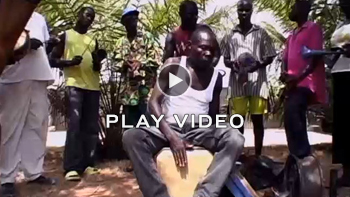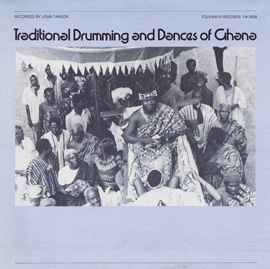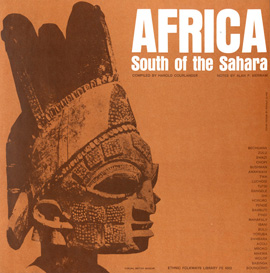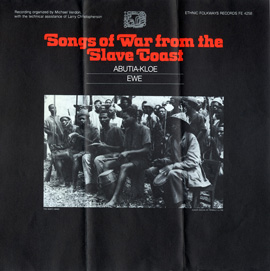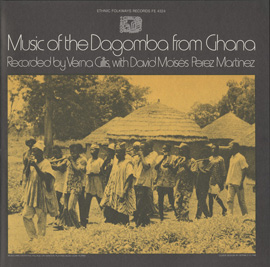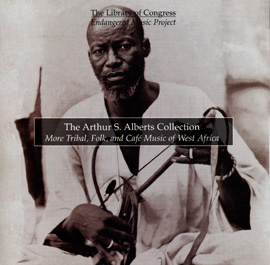Summary
With these segments, teachers are offered opportunities to use children’s music from Ghana, West Africa, to gain experience with basic polyrhythmic ensembles. Singing, chanting, dancing and playing instruments are included throughout the unit.
Suggested Grade Levels: 3-5, 6-8
Country: Ghana
Region: Volta Region, Ashanti Region, Central Region
Culture Group: Ewe, Akan, Ga
Genre: children’s social music
Instruments: Voice, Clapping, Firikiwa, Tokee, Gankogui, Drum
Language: Ewe, Twi, Ga
Co-Curricular Areas: Social Studies
National Standards: 1, 2, 5, 6, 7, 8, 9
Prerequisites: Experience with combining multiple rhythms together using voice and body percussion, reading quarter note/ two eighth notes/ quarter rest/ dotted quarter-eighth note
Objectives:
- Students will perform steady beat and rhythmic ostinato to recording of Ghanaian folk tune (National Standard 2)
- Students will sing and chant folk tunes from Ghana (National Standard 1)
- Students will read and clap/play rhythms extracted from Ghanaian folk tunes/chant (National Standards 1,2,5)
- Students will read and sing melody fragments extracted from Ghanaian folk melodies (National Standards 1,5)
- Students will learn about and play authentic instruments from Southern Ghana - firikiwa, tokee, gankogui (National Standards 2, 6, 7, 8, 9)
Material:
- Audio technology to play sound recordings
- Firikiwa (small iron castanet)
- Tokee (banana shape bell)
- Small drums
- Video technology to show Por Por Music video.
- “Gome”, Folk Music of Ghana, Folkways Records Album No. FW8859, c. 1964 by Folkways Records
- “Tuu! Tuu! Gbovi”, “Kaa Fo”, “Mede brebre masi ta”, African Songs and Rhythms For Children - Recorded and Annotated by Dr. W.K. Amoaku, SFW45011, c.1990 Smithsonian Folkways Recordings
- Companion book for “African Songs and Rhythms For Children”: Amoaku, W.U., “In the African Tradition - African Songs and Rhythms for Children, A Selection from Ghana, c. 1971 Schott, Germany
- La Drivers Union Por Por Group video
- Map of Ghana

Map from ghanaweb.com
Lesson Segments:
It is advisable that each lesson segment would incorporate a short review of the material from the previous lesson. By lesson segment four, there would be three familiar selections and one new selection. This unit would continue past lesson segment four until all material is mastered.
- “Gome” rhythmic ostinato using claps and moving (National Standards 5, 6, 7, 9)
- “Kaa Fo” singing with instrument accompaniment (National Standards 1, 2, 6, 7, 8, 9)
- “Mede Brebre Masi Ta” speech choir with drum (National Standards 1, 2, 5, 6, 7, 8, 9)
- “Tuu! Tuu! Gbovi” (National Standards 1, 2, 5, 6, 7, 8, 9)
Lesson Segment #1: “Gome” Rhythmic Ostinato Using Claps and Moving
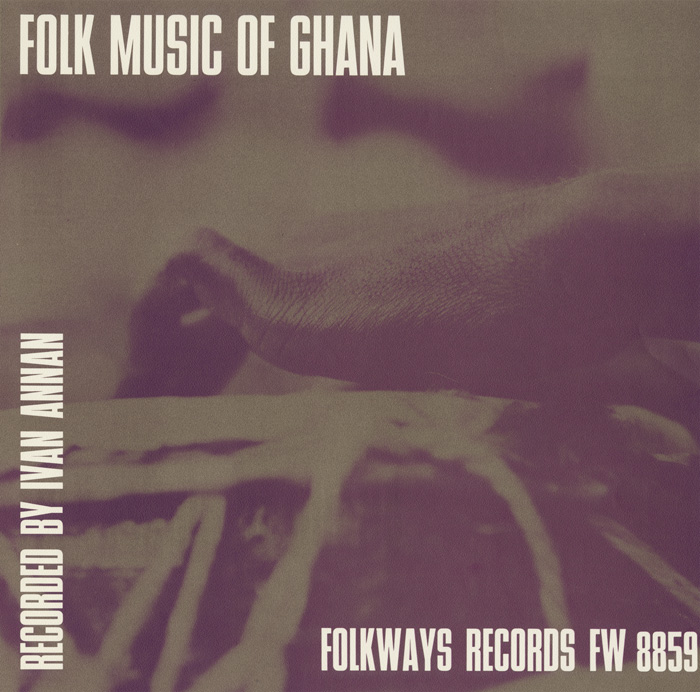
“Gome”
from Folk Music of Ghana (1964) | FW08859
Procedure:
1. Listen to “Gome”.
- Walk beat in place
- Count beat in groups of 4
- Clap on beat 1
- Clap on beat 1 and 4
- Add scooping hand motion on beat 2 & 3
2. Questions: Where might music be from? (Ghana - explore on map) What kind of voicing? (male voices, call and response, two parts) What instruments are heard? (sticks on side of drum, iron bell, drums)
- Inform the students that each of the over 100 ethnic groups have their own unique musical expressions, as well as some that are shared among them
- Fontomfrom comes from the Akan people in the Central Region of Ghana
- Display page 16 from the same liner notes and summarize the notes on the ensemble from page 12

3. Discuss role of music in daily life in Ghana. Use Por Por music video showing how taxi drivers have united and used music to represent themselves as an example of the way music is incorporated into all forms of expression.
Assessment: Demonstration by students of beat maintenance and clapping on correct beats without watching teacher and performance of Question and Answer components of song.
Lesson Segment #2. “Kaa Fo” Singing with Instrument Accompaniment

“Tu!Tu! Gbovi”
from African Songs and Rhythms For Children--Recorded and Annotated by Dr. W.K. Amoaku (1990) | SFW45011
“Kaa Fo”
“Mede Brebre Masi Ta”
Procedure:
1. Show phonetic pronunciation for text while playing recording of “Kaa Fo”.

Note - refer to the companion book for rythm patterns for accompaniment.
- Have students match claps while listening
2. Introduce firikiwa - teacher plays along with recording.
3. Students snap firikiwa rhythm while teacher plays along to recording.
4. Students take turns trying firikiwa, other students follow clapping pattern.
5. Teach pronunciation and translation. Learn melody.
6. Put together in three groups - a. singing b. clapping c. firikiwa. Rotate.
Assessment: Demonstration by students of steady beat, firikiwa rhythm pattern, small group singing and playing.
Lesson Segment #3. “Mede Brebre Masi Ta” Speech Choir with Drum
Procedure:
1. Extract segment of chorus part (koseh koseh koseh) and have students chant while they hear teacher speak solo part.

Note - refer to companion book for full translation, transcription and additional parts.
- Discuss translation.
- Extract another part of chorus (nyi ni nyi ni). Write the two extracted parts down on board with rhythm above. As teacher chants solo part, point at one of the chorus parts. Alternate at will.
- Alternate between extracted parts while hearing recording. Ask what they hear. (male voices).
- Teach simplified drum ostinato.
- Rotate through students in small groups or solos - one group on drum ostinato and on chorus parts while teacher chants solo.
Assessment: Student demonstration of having learned the song in a small group performance.
Lesson Segment #4. “Tuu! Tuu! Gbovi”
Procedure:
1. Prepare 3 rhythm patterns on flash cards or on board. Practice reading and then clapping.
2. Split class into three groups. Assign one of the rhythm patterns to each group. Practice and rotate.
3. Clap patterns along with recording.

Note - refer to companion book for pronunciation guide and rhythms.
4. Ask what they hear? (female voice and claps)
5. Transfer clapping patterns to firikiwa, tokee and gankogui.
Extension:
6. Song could be taught in the next/future lesson/s.
Assessment: Student demonstration of performance of song with singing and clapping patterns, and of understanding of rhythm patterns as per their sound and their notation.


